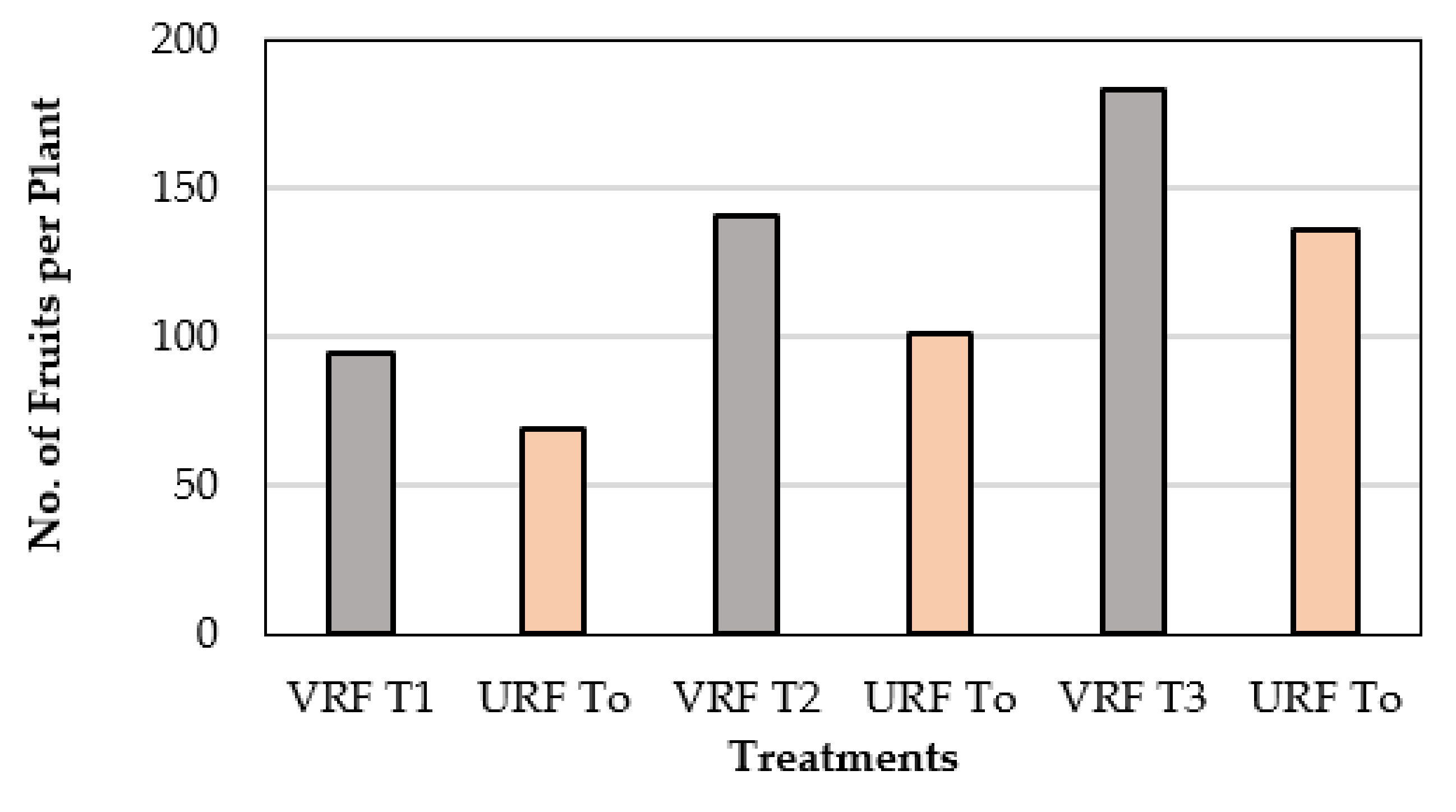Variable-Rate Fertilization for Citrus Orchard Management †
Abstract
:1. Introduction
2. Materials and Methods
2.1. Experimental Site
2.2. Experiment Framework
3. Results
3.1. Plant Height
3.2. Stem Girth
3.3. Interpolation of the Soil Nutrients
3.4. Fruit Yield
4. Conclusions
Author Contributions
Funding
Institutional Review Board Statement
Informed Consent Statement
Data Availability Statement
Conflicts of Interest
References
- Naz, S.; Shahzadi, K.; Rashid, S.; Saleem, F.; Zafarullah, A.; Ahmad, S. Molecular characterization and phylogenetic relationship of different citrus varieties of Pakistan. JAPS J. Anim. Plant Sci. 2014, 24, 315–320. [Google Scholar]
- Hassan, R.A.; Ali, S.; Zaheer, M.S.; Ali, H.H.; Iqbal, J.; Habib, A.; Nadeem, M.A.; Mumtaz, M.Z. In-vitro and in-vivo evaluation of different fungicides against leaf blight causing fungus Alternaria cucumerina in bitter gourd. J. Saudi Soc. Agric. Sci. 2022, 21, 208–215. [Google Scholar] [CrossRef]
- Seelan, S.K.; Laguette, S.; Casady, G.M.; Seielstad, G.A. Remote sensing applications for precision agriculture: A learning community approach. Remote. Sens. Environ. 2003, 88, 157–169. [Google Scholar] [CrossRef]
- El-Gioushy, S. Productivity, fruit quality and nutritional status of Washington navel orange trees as influenced by foliar application with salicylic acid and potassium silicate combinations. J. Hortic. Sci. Ornam. Plants 2016, 8, 98–107. [Google Scholar]
- Yang, C.; Everitt, J.; Bradford, J. Comparisons of uniform and variable rate nitrogen and phosphorus fertilizer applications for grain sorghum. Trans. ASAE 2001, 44, 201. [Google Scholar] [CrossRef]
- Colaço, A.; Molin, J.P. Variable rate fertilization in citrus: A long term study. Precis. Agric. 2017, 18, 169–191. [Google Scholar] [CrossRef]
- Ehsani, R.; Schumann, A.; Salyani, M. Variable Rate Technology for Florida Citrus: AE444/AE444; University of Florida: Gainesville, FL, USA, 2009. [Google Scholar]
- Nawar, S.; Corstanje, R.; Halcro, G.; Mulla, D.; Mouazen, A.M. Delineation of soil management zones for variable-rate fertilization: A review. Adv. Agron. 2017, 143, 175–245. [Google Scholar]



| Groups ID | Canopy Volume (ft3) | Nitrogen (g) | Phosphorous (g) | Potassium (g) |
|---|---|---|---|---|
| A1 | 300–450 | 875 | 1390 | 500 |
| A2 | 450–600 | 1050 | 1675 | 600 |
| A3 | 600–750 | 1250 | 1940 | 700 |
| Canopy Volume (ft3) | Sample | N | Mean | p-Value | Mean | *p-Value |
|---|---|---|---|---|---|---|
| July 2021 | July 2022 | |||||
| 300–450 | VRF | 3 | 8.20 | 0.0503 | 8.63 | 0.018087 |
| URF | 3 | 8.03 | 8.60 | |||
| 450–600 | VRF | 3 | 10.33 | 0.0236 | 10.83 | 0.008688 |
| URF | 3 | 9.83 | 10.43 | |||
| 600–750 | VRF | 3 | 9.90 | 0.0230 | 10.50 | 0.158950 |
| URF | 3 | 10.73 | 11.43 |
| Canopy Volume (ft3) | Sample | N | Mean | p-Value | Mean | *p-Value |
|---|---|---|---|---|---|---|
| July 2021 | July 2022 | |||||
| 300–450 | VRF | 3 | 15.66 | 0.400985 | 17.10 | 0.116486 |
| URF | 3 | 15.33 | 0.52 | |||
| 450–600 | VRF | 3 | 20.17 | 0.095855 | 1.60 | 0.113882 |
| URF | 3 | 19.00 | 3.00 | |||
| 600–750 | VRF | 3 | 18.50 | 0.044226 | 1.25 | 0.263621 |
| URF | 3 | 18.67 | 2.12 |
Disclaimer/Publisher’s Note: The statements, opinions and data contained in all publications are solely those of the individual author(s) and contributor(s) and not of MDPI and/or the editor(s). MDPI and/or the editor(s) disclaim responsibility for any injury to people or property resulting from any ideas, methods, instructions or products referred to in the content. |
© 2023 by the authors. Licensee MDPI, Basel, Switzerland. This article is an open access article distributed under the terms and conditions of the Creative Commons Attribution (CC BY) license (https://creativecommons.org/licenses/by/4.0/).
Share and Cite
Naqvi, S.M.M.; Khan, M.A.; Ali, I.; Saleem, S.; Shahzad, B.; Basit, A.; Farhan, M. Variable-Rate Fertilization for Citrus Orchard Management. Environ. Sci. Proc. 2022, 23, 37. https://doi.org/10.3390/environsciproc2022023037
Naqvi SMM, Khan MA, Ali I, Saleem S, Shahzad B, Basit A, Farhan M. Variable-Rate Fertilization for Citrus Orchard Management. Environmental Sciences Proceedings. 2022; 23(1):37. https://doi.org/10.3390/environsciproc2022023037
Chicago/Turabian StyleNaqvi, Syed Muiz Mehdi, Muhammad Azam Khan, Irfan Ali, Shoaib Saleem, Basit Shahzad, Abdul Basit, and Muhammad Farhan. 2022. "Variable-Rate Fertilization for Citrus Orchard Management" Environmental Sciences Proceedings 23, no. 1: 37. https://doi.org/10.3390/environsciproc2022023037
APA StyleNaqvi, S. M. M., Khan, M. A., Ali, I., Saleem, S., Shahzad, B., Basit, A., & Farhan, M. (2022). Variable-Rate Fertilization for Citrus Orchard Management. Environmental Sciences Proceedings, 23(1), 37. https://doi.org/10.3390/environsciproc2022023037







